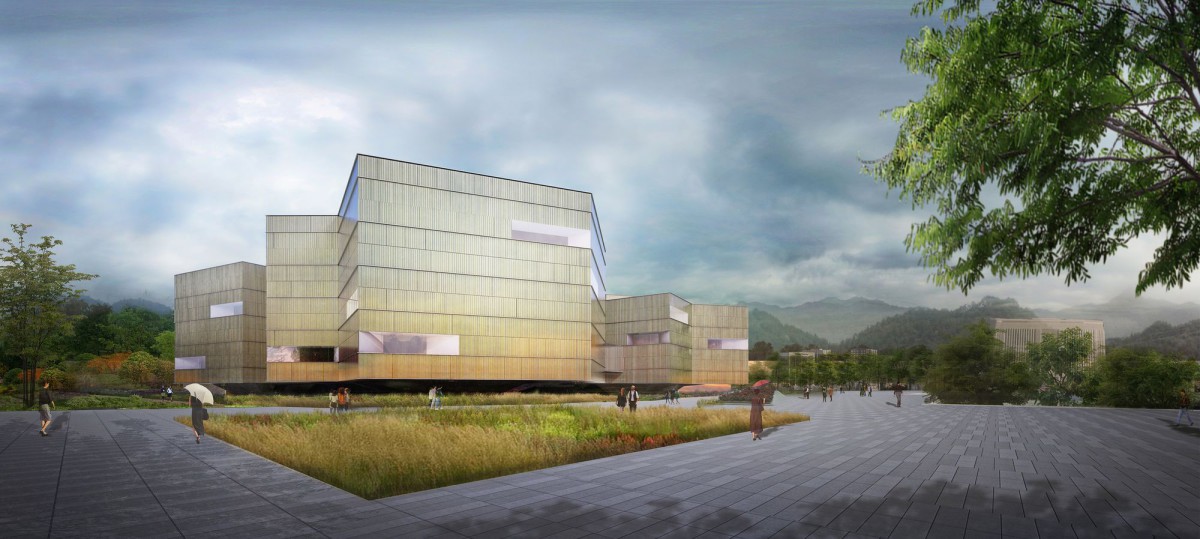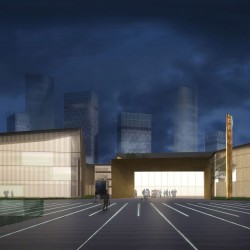The urban and architectural operation proposed presents two unique buildings: on the one hand the Heritage Museum, on the other hand the Digital Television Center and Cultural Center. Together they represent the activity, progress, and history of Hunan—a place of pride that endeavors to synthesize the past, present, and future of the province of Hunan and the city of Jishou, a place to remind the people of where they come from and of what their place in the future can be.
This reality can be manifested in different ways, but for sure it’s the public space, the large square between the two buildings, that plays a dominant role. The central square is not just an open space. It has symbolic value. It is a meeting point that can take in a variety of civic events and exhibitions, but it also takes on a symbolic role in the sense of representing two times: the past identified with ethnic groups, and the future having to do with technology and industry. A place, hence, of synthesis. A void full of meanings and intensities that allows us to experience the evolution of a nation within a prosperous China, Hunan, that while respecting the history and hard work of ancestors, knows to join the train of the future. This symbolic nature of the square, combined with the fact that very representative buildings rise on two sides, makes the urban space take on a theatrical character of great value. It is a place that represents all of society.
Our proposal for the Heritage Museum is, above all, about the importance of representation. It seeks to be the translation of a proud way of looking at history, at time, and especially at the people who have through the ages built the essences of Hunan as it is today; a nation that takes pride in itself.
The layout is simple. A linear volume joins and protects the glazed blocks, which interact as if they were dancing over a park.
La actuación urbana y arquitectónica propuesta contiene dos edificios singulares, el “Heritage Museum” y el “Digital Television Center and Cultural Center”. Ambos representan la actividad, el progreso y la historia de Hunan. Un lugar de orgullo que pretende sintetizar el pasado, el presente y el futuro de la provincia de Hunan y la ciudad de Jishou. Un lugar para demostrar a los ciudadanos de donde vienen y cual puede ser su lugar en el futuro.
Esta realidad puede manifestarse de distintas maneras, pero sin duda es al espacio público, a la gran plaza que se sitúa entre los dos edificios al que le ocupa un papel preponderante para lograrlo. La plaza central no es solo un espacio libre sino que tiene un valor simbólico. Es un lugar de encuentro donde se podrán organizar distintos manifestaciones y exposiciones por parte de los ciudadanos, pero asume también un papel simbólico en la medida que representa dos tiempos, el pasado identificado con las etnias y el futuro que tiene que ver con la tecnología y la industria. Lugar por tanto de síntesis, vacío repleto de significados e intensidades que permiten vivir la evolución de un pueblo, el de Hunan, en una China próspera que, a la vez que respeta la historia y el trabajo de los antepasados, sabe incorporarse al tren del futuro. Esta condición simbólica, unido al hecho de que a los lados se levantan dos edificios tan representativos hacen que el citado espacio urbano adquiera una condición escenográfica de gran valor. Es un lugar que representa a toda una sociedad.
El edificio que proponemos se basa sobre todo en el valor de la representación. Es la traducción de una manera orgullosa de entender la historia, el tiempo y, sobre todo, las gentes que han construido las esencias del Hunan de hoy a lo largo del tiempo. De un pueblo que se siente orgulloso de lo suyo.
La organización es simple. Un cuerpo lineal une y arropa los volúmenes vítreos que se reúnen como si estuvieran bailando sobre el parque.
Los volúmenes que flotan sobre el parque son como las rocas que invaden los valles de la región. Representan las diferentes etnias que a lo largo del tiempo han configurado la Hunan de nuestros días. Representan pues la historia y el tiempo. Representan lo más sagrado de la cultura, el espíritu de unión.







Comments are closed.